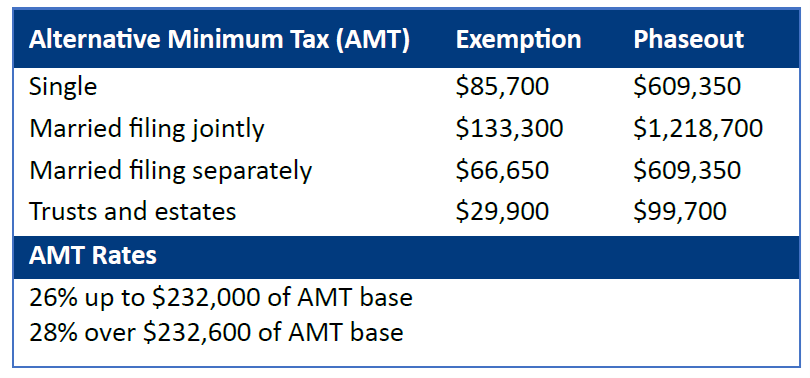Understanding the Alternative Minimum Tax: What You Need to Know
The Alternative Minimum Tax (AMT) stands as a crucial component of the United States tax system, designed to ensure that all taxpayers, especially those with higher incomes, pay their fair share of taxes. Initially implemented to prevent wealthy individuals from using excessive deductions and credits to drastically lower their tax liabilities, the AMT has evolved into a parallel tax system that affects a broad spectrum of taxpayers. This comprehensive guide will cover the complexities of the AMT, helping you understand how it works, how to calculate your AMT exemption, and strategies to avoid triggering the AMT in your financial planning. To learn more, see our in-depth page on The Alternative Minimum Tax (AMT) Explained and How to Avoid It.
What is the Alternative Minimum Tax (AMT) and How Does it Work?
Understanding the Purpose of the AMT
The AMT was created as a secondary method of calculating income tax, intended to ensure that individuals and corporations with substantial earnings pay a minimum level of federal income tax, regardless of their regular tax deductions and credits. This parallel tax system adjusts the taxable income by adding back various tax preference items into an individual’s income. The rationale behind this system is to maintain fairness within the income tax system, preventing those with the means to claim multiple tax breaks from avoiding their share of tax liabilities.
The Differences Between AMT and Regular Income Tax
Comparing the AMT with the regular income tax system reveals distinct differences in their calculation and the tax rates applied. While the regular income tax system is progressive, with tax rates increasing as income rises, the AMT operates with just two tax brackets or AMT rates. Another significant difference lies in how taxable income is determined: the AMT system mandates the addition of certain tax preference items back into the taxable income, thereby broadening the base amount of income subject to the AMT. This recalibration can result in a higher tax liability under the AMT, particularly for those who traditionally benefit from specific deductions and exemptions under the regular tax system.
Calculating the AMT: A Basic Overview
Calculating whether you need to pay the AMT involves a multi-step process, beginning with determining your alternative minimum taxable income (AMTI). To compute your AMTI, you start with your regular taxable income and then add or subtract AMT preference adjustments, including state and local tax deductions, personal exemptions, and standard deductions, which are disallowed under the AMT rules. Following this, an AMT exemption amount is subtracted from the AMTI to arrive at the amount that will be taxed under the AMT tax rates. If the tax calculated through this method is higher than your regular tax liability, you’ll be required to pay the AMT.
How to Calculate Your AMT Exemption in Tax Year 2024
Understanding AMT Exemption Amounts
The AMT exemption is a critical component in calculating the AMT, serving as a threshold below which taxpayers are not subject to the AMT. The AMT exemption amount is adjusted annually for inflation and varies depending on your filing status. In 2024, for example, exemption amounts were set at differing levels for single filers, married couples filing jointly, and married individuals filing separately. These exemptions serve to mitigate the effect of the AMT on taxpayers with lower amounts of alternative minimum taxable income.

Step-by-Step Guide to Calculating Your AMT Exemption
To calculate your AMT exemption for the 2024 tax year, you should begin by determining your AMTI, as previously described. Next, you’ll apply the exemption amount appropriate for your filing status. However, it’s important to note that these exemption amounts begin to phase out at higher income levels. This means that as your income increases beyond a certain threshold, the exemption amount is gradually reduced, potentially increasing your AMT liability. Tax software or a tax professional can aid in accurately calculating these amounts and phase-outs based on your specific financial situation.
The Impact of Tax Year Updates on AMT Exemption
Each tax year brings adjustments to the AMT exemption amounts and phase-out thresholds, reflecting changes in the economy and tax law. For instance, modifications made by the Tax Cuts and Jobs Act have significantly increased AMT exemption amounts and the income levels at which the exemptions begin to phase out. These updates can affect your AMT liability, potentially reducing the number of taxpayers subject to the AMT. Staying informed about these changes is vital for effective tax planning and avoiding unexpected tax liabilities. For 2024, TJCA increased the exemption amounts so that fewer people paid the AMT tax. In 2026, it is estimated that more than 5 million people will be subject to AMT. The current AMT exemption is $85,700 for individuals and $133,300 for married filing jointly.
Could Your Tax Breaks Trigger the Alternative Minimum Tax?
What Tax Breaks Often Trigger the AMT?
Certain tax breaks, while beneficial under the regular tax system, can trigger the AMT. Predominantly, deductions for state and local taxes, significant medical expenses, and miscellaneous itemized deductions, including unreimbursed employee expenses, are added back to taxable income for AMT purposes. High levels of personal exemptions, or the exercise of incentive stock options, can also increase AMT liability. Essentially, these tax benefits, which reduce your taxable income for regular tax purposes, can result in a higher tax bill under the AMT by increasing your alternative minimum taxable income.
How to Avoid AMT Triggers with Strategic Tax Planning
Avoiding the triggers of the AMT requires careful and strategic tax planning, especially for taxpayers who are close to the AMT threshold. One approach is to spread out income and deductions over multiple years to prevent large fluctuations that could push you into the AMT zone. Adjusting your tax withholdings and estimated tax payments can also play a role in managing potential AMT liabilities. Engaging in strategic tax planning for federal employees can provide personalized advice and strategies to navigate around AMT triggers based on individual financial circumstances.
Utilizing AMT Credit to Offset Potential Triggers
For taxpayers who have previously paid the AMT, the AMT credit is a valuable tool for offsetting future regular tax liabilities. This credit allows individuals to reclaim part of the difference between their AMT and regular tax liabilities from previous years. However, leveraging the AMT credit requires careful tax planning and may depend on the nature of the tax preferences that initially caused the AMT liability. Accurate record-keeping and potentially the assistance of tax software or a tax advisor are crucial for maximizing the benefit of the AMT credit.
Strategies to Avoid Paying the AMT in Future Tax Years
Adjusting Withholding and Estimated Tax Payments to Avoid the AMT
One of the proactive strategies for avoiding the AMT involves adjusting your withholding amounts and estimated tax payments. By accurately predicting your tax obligations and adjusting these payments accordingly, you can prevent significant underpayments or overpayments that might contribute to an AMT liability. This approach requires a good understanding of your financial situation and potential tax deductions or credits that may affect your tax bill. Consider using tax planning software or consulting a tax professional to ensure your calculations are accurate and to avoid triggering the AMT.
Investment Strategies to Minimize AMT Liability
Incorporating specific investment strategies can also play a significant role in minimizing your AMT liability. For instance, using a tax-managed investment strategy or deferring certain types of income can reduce your alternative minimum taxable income. Likewise, managing the timing of large capital gains or losses and understanding how these can impact your AMT liability are important components of a tax-efficient investment strategy. Again, professional advice may be beneficial in structuring your investments to minimize exposure to the AMT.
When to Consult a Tax Professional about the AMT
While understanding the basics of the AMT and engaging in strategic tax planning can help many navigate their tax obligations, the complexities of the AMT often necessitate professional assistance. If you find yourself consistently close to or hit with the AMT, consulting with a tax professional can provide clarity and direction. Tax advisors can offer personalized strategies for reducing your AMT liability and help you understand how changes in tax laws, such as the Tax Cuts and Jobs Act, impact your specific situation.
Understanding the Impact of the Tax Cuts and Jobs Act on AMT Rates and Exemptions
How the Tax Cuts and Jobs Act Modified the AMT for Individuals
The Tax Cuts and Jobs Act, enacted in late 2017, brought significant changes to the AMT for individuals. One of the most impactful modifications was the increase in AMT exemption amounts and the rise in the income thresholds at which these exemptions begin to phase out. These changes were designed to reduce the number of taxpayers affected by the AMT, simplifying tax filing and reducing the tax burden for many middle and upper-middle-class taxpayers. However, these changes are set to expire after 2025, raising questions about future AMT liabilities.
Exploring Changes to Exemption Amounts and Phase-Out Thresholds
Under the Tax Cuts and Jobs Act, the AMT exemption amounts for various filing statuses saw significant increases, and the income levels at which the exemptions phase out were also raised. These changes effectively removed many taxpayers from the AMT’s reach, particularly those with moderate to high incomes who previously might have been subject to this alternative tax system. Nevertheless, as these adjustments are temporary, staying informed about potential tax law changes is essential for effective long-term tax planning.
Future Projections: Will the AMT Become More Common or Less Prevalent?
As the provisions of the Tax Cuts and Jobs Act are scheduled to sunset after 2025, the future prevalence of the AMT is uncertain. Should these changes be allowed to expire without further legislative action, the AMT could once again affect a broader range of taxpayers, reinstating its original role as a mechanism to ensure that wealthier taxpayers pay a minimum amount of tax. Continuous monitoring of legislative developments and adapting tax planning strategies accordingly will be crucial for taxpayers seeking to manage their AMT exposure in the coming years.
Reach Out to Us!
If you have additional federal benefit questions, reach out to our team of CERTIFIED FINANCIAL PLANNER™ (CFP®) and Chartered Federal Employee Benefits Consultants (ChFEBC℠). We also hold the Accredited Investment Fiduciary (AIF®) designation. At PlanWell, we focus on retirement planning for federal employees. If you’re seeking a specialized financial advisor for federal employees, learn more about our process designed for the career federal employee.
Preparing for a federal retirement? Check out our scheduled federal retirement workshops. Sign up for our no-cost federal retirement webinars. Make sure to plan ahead and reserve your seat for our FERS webinar, held every three weeks. Want to have PlanWell host a federal retirement seminar for your agency? Reach out and we’ll collaborate with HR to arrange an on-site FERS seminar.
Want to fast track your federal retirement plan? Skip the FERS webinar and start a one-on-one conversation with a ChFEBC today. You can schedule a one-on-one meeting by visiting our Contact page.










